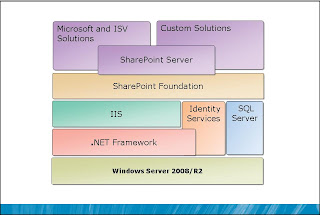Last week, I attended a Microsoft course for SharePoint 2010. I just want to share some of the key points that has been discussed.
Evaluating the Features of SharePoint 2010
SharePoint 2010 is the business collaboration platform for the enterprise and the Internet. Behind this simple value proposition is a complex and powerful platform that delivers rich functionality to address a vast range of business needs.
The Value Proposition of SharePoint 2010
The value proposition for SharePoint is, “SharePoint is the business collaboration platform for the enterprise and the Internet.” Microsoft invested heavily in the development of SharePoint Server 2010 to deliver features that enable an
enterprise to do the following:
- Deliver the best productivity experience. The end-user experience of SharePoint Server 2010 builds on familiar user interfaces and tools.
- Cut costs with a unified infrastructure. SharePoint 2010 performs roles that have been, in many enterprises, provided by other disparate systems. Now those roles can be consolidated on to SharePoint 2010.
- Rapidly respond to business needs. SharePoint 2010 provides a diverse feature set addressing many business collaboration scenarios, with out of box functionality, a rich collection of community-generated solutions, and extensibility to support custom solutions.
The SharePoint Platform
SharePoint is a platform that itself extends and depends on many components of the broader Microsoft technologies suite.
This visualization of the platform shows the dependencies—both required and available—between components of the technology stack. Each component of the platform contributes specific features and functionality.
- Windows Server 2008 or Windows Server 2008 R2 provides the core operating system functionality, including the security subsystem.
- The Microsoft .NET Framework provides the framework for SharePoint, which is a .NET application running within Internet Information Services (IIS).
- SharePoint Foundation 2010 delivers fundamental SharePoint functionality including service management, security, integration with Microsoft Office client applications, and core collaborative features such as lists and libraries.
- SharePoint Server 2010 builds on SharePoint Foundation, adding social networking, enterprise search, business intelligence, and other features.
- SharePoint uses identity services that can include the Active Directory directory service or other Claims-based authentication providers. Some of these identity services, such as forms-based authentication, rely on the .NET Framework.
- SharePoint content is stored in Microsoft SQL Server.
- SharePoint is a highly extensible platform. Independent software vendors (ISVs), the community, customers, and Microsoft itself deliver solutions that depend on SharePoint Foundation or SharePoint Server.
SharePoint Products and Technologies
There is a wide array of products and technologies that make up SharePoint.
SharePoint products and technologies include the following:
- SharePoint Foundation 2010.
- SharePoint Server 2010 for Intranet Scenarios, which is licensed with Standard or Enterprise features. The features provided by SharePoint Foundation 2010 and SharePoint Server 2010 are detailed later in this module.
- SharePoint Server 2010 for Internet Sites, which is licensed for access by large numbers of users and by nonauthenticated users.
- Office Web Apps.
- FAST Search for SharePoint 2010.
- FAST Search for SharePoint 2010 for Internet Sites, which is licensed for access by large numbers of users and by nonauthenticated users.
- Search Server 2010 and Search Server Express 2010, which provide the search functionality of SharePoint Server.
Additionally, a vast selection of community-generated solutions and applications by ISVs extends the capabilities and feature set of SharePoint 2010.




No comments:
Post a Comment